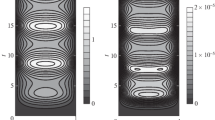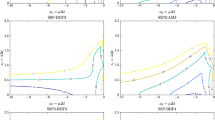Abstract
In the simulation of dynamical processes in economy, social sciences, biology or chemistry, the analyzed values often represent non-negative quantities like the amount of goods or individuals or the density of a chemical or biological species. Such systems are typically described by positive ordinary differential equations (ODEs) that have a non-negative solution for every non-negative initial value. Besides positivity, these processes often are subject to algebraic constraints that result from conservation laws, limitation of resources, or balance conditions and thus the models are differential-algebraic equations (DAEs). In this work, we present conditions under which both these properties, the positivity as well as the algebraic constraints, are preserved in the numerical simulation by Runge–Kutta or multistep discretization methods. Using a decomposition approach, we separate the dynamic and the algebraic equations of a given linear, positive DAE to give positivity preserving conditions for each part separately. For the dynamic part, we generalize the results for positive ODEs to DAEs using the solution representation via Drazin inverses. For the algebraic part, we use the consistency conditions of the discretization method to derive conditions under which this part of the approximation overestimates the exact solution and thus is non-negative. We analyze these conditions for some common Runge–Kutta and multistep methods and observe that for index-1 systems and stiffly accurate Runge–Kutta methods, positivity is conditionally preserved under similar conditions as for ODEs. For higher index problems, however, none of the common methods is suitable.

Similar content being viewed by others
References
Anderson, A., Chaplain, M., Newmann, E., Steele, R., Thompson, A.: Mathematical modelling of tumour invasion and metastasis. J. Theor. Med. 2, 129–154 (2000)
Anderson, B.D.O.: New developments in the theory of positive systems. In: Byrnes, C. (ed) Systems and Control in the Twenty-First Century, Progr. Systems Control Theory, vol. 22, pp. 17–36. Birkhäuser, Boston (1997)
Baum, A., Mehrmann, V.: Numerical integration of positive linear differential-algebraic systems. Institut für Mathematik, TU Berlin, Str. des 17. Juni 136, D-10623 Berlin, FRG (2012, preprint)
Benvenuti, L., De Santis, A., Farina, L.: Positive Systems, vol. 294. Springer, Berlin (2003)
Benvenuti, L., Farina, L.: Positive and compartmental systems. IEEE Trans. Autom. Control 47, 370–373 (2002)
Birkhoff, G., Varga, R.S.: Reactor criticality and non-negative matrices. J. Soc. Ind. Appl. Math. 6, 354–377 (1958)
Bolley, C., Crouzeix, M.: Conservation de la positivité lors de la discrétisation des problemes d’évolution paraboliques. R.A.I.R.O. Analyse numerique 12, 81–88 (1978)
Butcher, J.: The Numerical Analysis of Ordinary Differential Equations: Runge-Kutta and General Linear Methods. Wiley, Chichester (1987)
Campbell, S.: Singular Systems of Differential Equations I. Pitman, San Francisco (1980)
Campbell, S., Meyer, C.: Generalized Inverses of Linear Transformations. Pitman, San Francisco (1979)
Capasso, V.: Mathematical Structures of Epidemic Systems. Springer, Berlin (1993)
Commault, C., Marchand, N.: Positive Systems, vol. 341. Springer, Berlin (2006)
Dahlquist, G.: Convergence and stability in the numerical integration of ordinary differential equations. Math. Scand. 4, 33–53 (1956)
Farina, L., Rinaldi, S.: Positive Linear Systems: Theory and its Applications. Wiley, New York (2000)
Gandolfo, G.: Economic Dynamics. Springer, Heidelberg (1997)
Gantmacher, F.: The Theory of Matrices, vol. 1. Chelsea Publishing Company, New York (1959)
Gottlieb, S., Ketcheson, D., Shu, C.: Strong Stability Preserving Runge-Kutta and Multistep Time Discretizations. World Scientific Publishing Company, Singapore (2011)
Griend, J., Kraaijevanger, J.: Absolute monotonicity of rational functions occuring in the numerical study of initial value problems. Numer. Math. 49, 413–424 (1986)
Hairer, E., Lubich, C., Roche, M.: The Numerical Solution of Differential-Algebraic Systems by Runge–Kutta Methods. Springer, Berlin (1989)
Hairer, E., Noersett, S., Wanner, G.: Solving Ordinary Differential Equations I: Nonstiff Problems, 2nd edn. Springer, Berlin (1993)
Hairer, E., Wanner, G.: Solving Ordinary Differential Equations II Stiff and Differential-Algebraic Problems, 2nd edn. Springer, Berlin (1996)
Horn, R., Johnson, C.: Topics in Matrix Analysis. Cambridge University Press, Cambridge (1991)
Horvath, Z.: Positivity of Runge–Kutta and diagonally split Runge–Kutta methods. Appl. Numer. Math. 28, 309–326 (1998)
Horvath, Z.: Positively invariant cones of dynamical systems under Runge–Kutta and Rosenbrock-type discretization. Proc. Appl. Math. Mech. (PAMM) 4, 688–689 (2004). doi:10.1002/pamm.200410325
Horvath, Z.: On the positivity step size threshold of Runge–Kutta methods. Appl. Numer. Math. 53, 341–356 (2005)
Hundsdorfer, W., Koren, B., van Loon, M., Verwer, J.: A positive finite-difference advection scheme. J. Comp. Phys. 117, 35–46 (1994)
Hundsdorfer, W., Verwer, J.G.: Numerical Solution of Time-Dependent Advection-Diffusion-Reaction Equations. Springer, Berlin (2003)
Kaczorek, T.: Positive 1D and 2D Systems. Springer, London (2002)
Ketcheson, D.: Computation of optimal monotonicity preserving general linear methods. Math. Comp. 78(267), 1497–1513 (2009)
King, J., Unterkofler, K., Teschl, G., Teschl, S., Koc, H., Hinterhuber, H., Amann, A.: A mathematical model for breath gas analysis of volatile organic compounds with special emphasis on acetone. J. Math. Biol. 63(5), 959–999 (2011)
Kraaijevanger, J.: Absolute monotonicity of polynomials occuring in the numerical soution of initial value problems. Numer. Math. 48, 303–322 (1986)
Kunkel, P., Mehrmann, V.: Differential-Algebraic Equations Analysis and Numerical Solution. EMS Publishing House, Zürich (2006)
Lancaster, P., Tismenetsky, M.: The Theory of Matrices. Academic Press, New York (1985)
Laub, A.: Matrix analysis for scientists and engineers. Society for Industrial and Applied Mathematics, Philadelphia (2005)
Lenferink, H.: Contractivity preserving explicit linear multistep methods. Numer. Math. 55, 213–223 (1989)
Lenferink, H.: Contractivity preserving implicit linear multistep methods. Math. Comp. 56, 177–199 (1991)
Luenberger, D.G.: Introduction to Dynamic Systems. Wiley, New York (1979)
Murray, J., Lubkin, S., Tyson, R.: Model and analysis of chemotactic bacterial patters in a liquid medium. J. Math. Biol. 38, 359–75 (1999)
Spijker, M.: Stepsize conditions for general monotonicity in numerical initial value problems. SIAM Num Anal 45, 1226–1245 (2007)
Stoer, J., Bulirsch, R.: Introduction to Numerical Analysis. Springer, Berlin (2002)
Tian, H.: On the reverse order law \(({AB})^{D}= {B}^{D}{A}^{D}\). Numer. Math. J. Chin. Univ. 9(1), 355–358 (2000)
Varga, R.: Matrix Iterative Analysis, 2nd edn. Springer, Berlin (2000)
Virnik, E.: Stability analysis of positive descriptor systems. Linear Algebra Appl. 429, 2640–2659 (2008)
Author information
Authors and Affiliations
Corresponding author
Additional information
V. Mehrmann was supported by ERC Advanced Grant, MODSIMCONMP.
This study was supported by DFG Research Center Matheon, Mathematics for Key Technologies in Berlin.
Rights and permissions
About this article
Cite this article
Baum, A.K., Mehrmann, V. Numerical integration of positive linear differential-algebraic systems. Numer. Math. 124, 279–307 (2013). https://doi.org/10.1007/s00211-013-0514-z
Received:
Revised:
Published:
Issue Date:
DOI: https://doi.org/10.1007/s00211-013-0514-z




